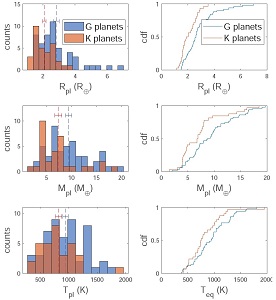Why do more massive stars host larger planets?
- Details
- Published on 18 August 2021
Vol. 652
10. Planets and planetary systems
Why do more massive stars host larger planets?

The increasing database of exoplanets allows us to explore how planetary populations vary on stellar mass. For relatively small K and G stars (masses ~< 1.2 M_sun), a study by Pascucci et al. (2018) has suggested that, on average, planetary masses increase almost linearly with stellar mass, with a universal (i.e., independent on the stellar type) peak in the planet-to-star mass ratio. This also means that the radius of the most common planet increases with the stellar host's mass. A well-identified reason for a large planetary radius is a large fraction of volatile material (H-He atmospheres), but other causes are plausible, such as increased thermal inflation or a larger planetary system mass, both of which could be associated to more massive and luminous host stars. Lozovsky et al. examine correlations between stellar mass and various planetary properties for G- and K- stars to sort out these possibilities. Beyond confirming the results of Pascucci et al. on the relation between planetary and stellar masses, they find that the planetary radii do not correlate with equilibrium temperatures, dismissing the role of thermal inflation in the observed trends. Using planetary models of various compositions, they computed mass-radius (M-R) relations and show that, given the flatness of the M-R curves in the range of interest, the typical difference of mass between G- and K-star planets, about 2 M_Earth, is far too small to explain the typical difference in observed radii, about 0.75 R_Earth. In contrast, varying the H-He mass fraction can readily explain the range of planetary radii and the G versus K difference, with the G-star planets being more volatile-rich in comparison to K-star planets. The authors conclude that planets around more massive stars include larger amounts of H-He. This may suggest that planets forming around more massive stars accrete H-He atmospheres more efficiently.

